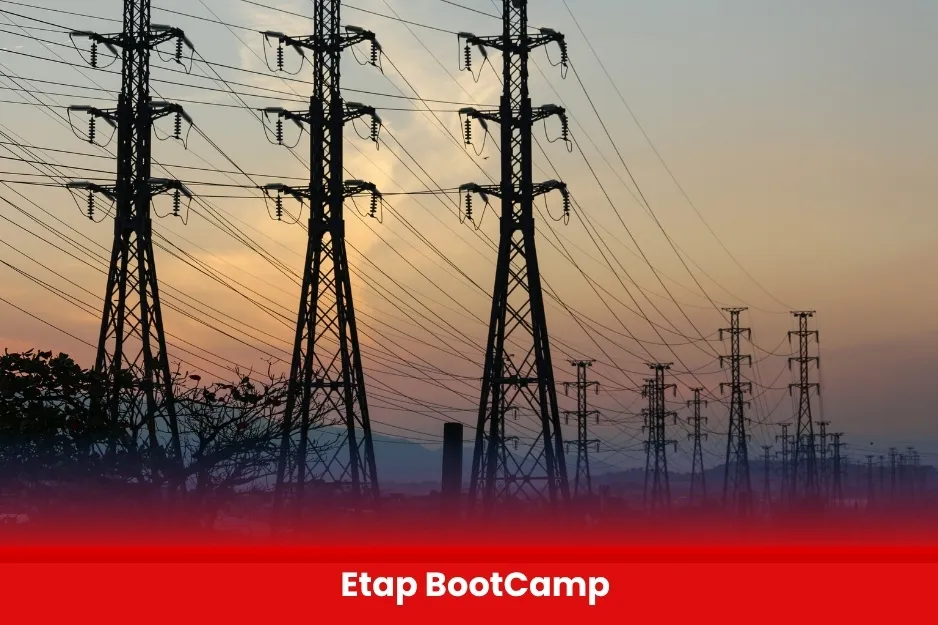Etap BootCamp
BURRAQ UK is a leading training and consultancy organization committed to empowering individuals and professionals through high-quality, industry-relevant technical education. BURRAQ UK is known for delivering industry-focused, practical training that bridges the gap between academic learning and real-world applications.

Aim of Etap BootCamp
The primary aim of the ETAP BootCamp is to provide participants with practical, hands-on training in using ETAP (Electrical Transient and Analysis Program) for the design, simulation, analysis, and optimization of electrical power systems.
Course Overview
Etap BootCamp
Total Modules 10
Training Credits 30
Directed Learning Hours (DLH) 300
Course Code BUK1151
- Must have a background in Electrical or Power Engineering (Diploma, Undergraduate, or Postgraduate level).
- Fresh graduates or final-year students in electrical-related fields are eligible to apply.
- Professionals working in the electrical, utility, energy, or industrial automation sectors are encouraged to participate.
- Basic understanding of electrical circuits and power systems is recommended.
- Prior experience with ETAP is not required, as the BootCamp covers content from the beginner level.
| Course Code | Curriculum Title | Credit | DLH |
|---|---|---|---|
| BUK1151-1 | ETAP Software Installation | 3 | 30 |
| BUK1151-2 | Introduction to ETAP Software | 3 | 30 |
| BUK1151-3 | How to Create a New Project in ETAP | 3 | 30 |
| BUK1151-4 | Introduction to ETAP Database | 3 | 30 |
| BUK1151-5 | ETAP toolbar introduction | 3 | 30 |
| BUK1151-6 | Composite Network in ETAP | 3 | 30 |
| BUK1151-7 | Creating a template and importing it to one line diagram | 3 | 30 |
| BUK1151-8 | Equipment Evaluation | 3 | 30 |
| BUK1151-9 | How to Fault a bus | 3 | 30 |
| BUK1151-10 | Setting up the Motor Parameters | 3 | 30 |
Objectives
- ETAP Software Installation
- Introduction to ETAP Software
- How to Create a New Project in ETAP
- How to Load the existing Project
- Introduction to ETAP Database
- ETAP toolbar introduction
- One Line Diagram in ETAP
- Create your first one-line diagram
- Composite Network in ETAP
- Customize the library for the relay breaker and fuse
- Creating a template and importing it to one line diagram
- Load Flow Study Evaluation and Result Analysis
- Run Load Analysis on Single Line Diagram
- Equipment Evaluation
- Voltage Drop Calculations
- Bus Voltages, Cable voltage Drops
- Bus Under voltage
- Cable overload
- Cable Sizing Studies
- Transformer Overload
- Transformer Sizing
- Alert View in ETAP
- Critical and Marginal Conditions in ETAP
- Arc Flash and Short Circuit Analysis
- Run Short circuit and Arc Flash Analysis
- Short Circuit Current Evaluation
- How to Fault a bus
- Edit Study Case
- Motor Start Analysis
- Setting up the Motor Rating
- Motor Start static
- Setting up the Motor Events in Edit Study Case
- Starting Current and its Plot in ETAP
- Motor Start Dynamic
- Setting up the Motor Parameters
- Setting up the Motor Inertia, Load
- Motor Start Dynamic using VFD
- Breaker Settings
- CT settings
- How to generate a report on ETAP
- Introduction to ETAP Level 2 Training
- Diploma, BSc, or MSc students in Electrical or Power Engineering
- Fresh graduates aiming to strengthen their technical profiles
- Working professionals in power plants, utilities, industrial automation, or electrical design fields
- Technical instructors and lab engineers involved in teaching or training
- Anyone with a basic understanding of electrical systems and a desire to learn ETAP
- All Modules within this qualification are assessed internally by the approved training Centre and externally verified by BURRAQ UK. The program uses a criterion-referenced assessment approach to ensure that learners successfully meet all required learning outcomes.
- A Pass in any unit is granted only when the learner submits valid, reliable, and authentic evidence that demonstrates achievement of the assessment criteria. The Assessor is responsible for reviewing this evidence and confirming that the learner has attained the expected standard.
